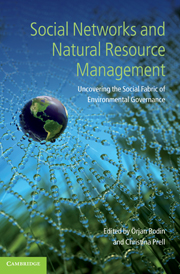 Social Networks and Natural Resource Management
Social Networks and Natural Resource Management from Part I - Introduction
Published online by Cambridge University Press: 05 June 2012
Introduction
For much of the twentieth century natural resource management centered on efforts to control nature in order to harvest products from it, while reducing risks to society. The central tenet was to achieve predictable outcomes, a strategy that almost invariably led to reduced biological diversity and a reduction of the range of variation in natural systems. However, reduced diversity, in turn, tends to create more sensitive systems, both ecological and social (Levin, 1999), and examples of this today are the highly controlled systems of conventional agriculture and forestry that are experiencing increasing problems, fighting pest outbreaks and declining populations of natural pollinators (Chapin et al., 2000; Lundberg and Moberg, 2003). From the 1970s onwards (Holling, 1973, 1978), it has been suggested that such attempts to control highly complex and non-linear systems inevitably lead to surprises and/or societal and environmental crises (Holling and Meffe, 1995). On the basis of these arguments, conventional resource management, or command-and-control management as it is often referred to, has been heavily criticized (Holling, 1973; Holling et al., 1995; Wondolleck and Yaffee, 2000; Folke et al., 2005, among many others) and several approaches have been proposed to overcome some of its limitations. These include, among others, adaptive management (Holling, 1978), cooperative management (Pinkerton, 1989; Jentoft, 2000), collaborative management (Borrini-Feyerabend and Borrini, 1996; Wondolleck and Yaffee, 2000), and adaptive co-management (Ruitenbeek and Cartier, 2001; Olsson et al., 2004a). These concepts share many similarities and readers are referred to Folke et al. (2005) and Armitage et al. (2008a, 2008b) for more in-depth reviews.
To save this book to your Kindle, first ensure no-reply@cambridge.org is added to your Approved Personal Document E-mail List under your Personal Document Settings on the Manage Your Content and Devices page of your Amazon account. Then enter the ‘name’ part of your Kindle email address below. Find out more about saving to your Kindle.
Note you can select to save to either the @free.kindle.com or @kindle.com variations. ‘@free.kindle.com’ emails are free but can only be saved to your device when it is connected to wi-fi. ‘@kindle.com’ emails can be delivered even when you are not connected to wi-fi, but note that service fees apply.
Find out more about the Kindle Personal Document Service.
To save content items to your account, please confirm that you agree to abide by our usage policies. If this is the first time you use this feature, you will be asked to authorise Cambridge Core to connect with your account. Find out more about saving content to Dropbox.
To save content items to your account, please confirm that you agree to abide by our usage policies. If this is the first time you use this feature, you will be asked to authorise Cambridge Core to connect with your account. Find out more about saving content to Google Drive.